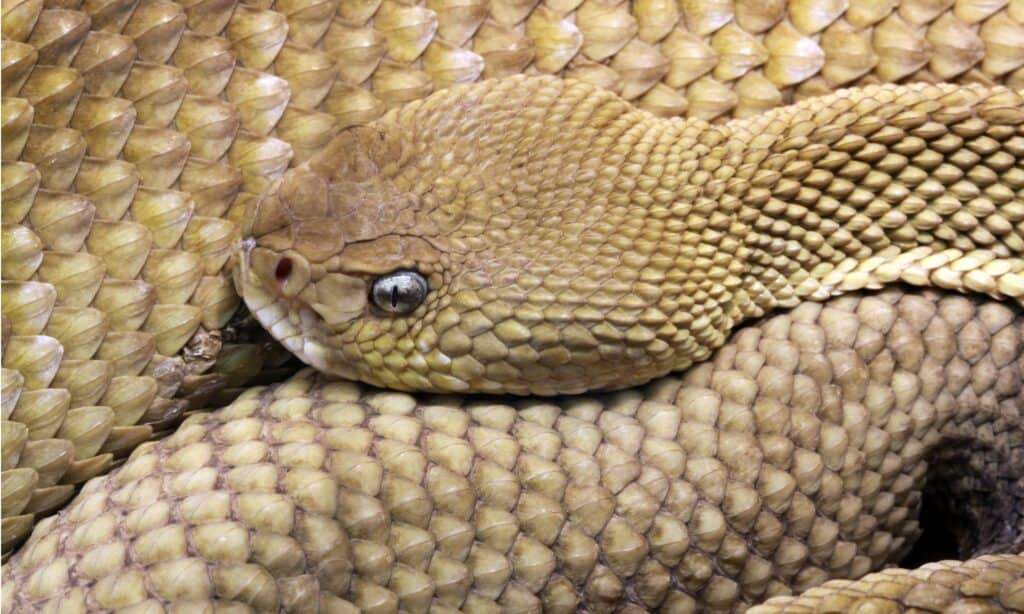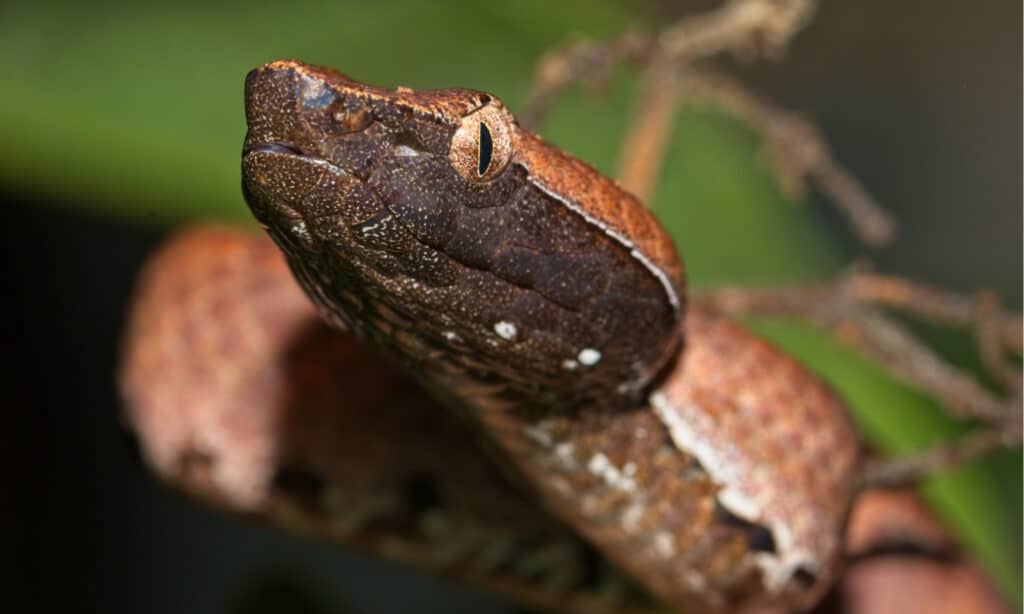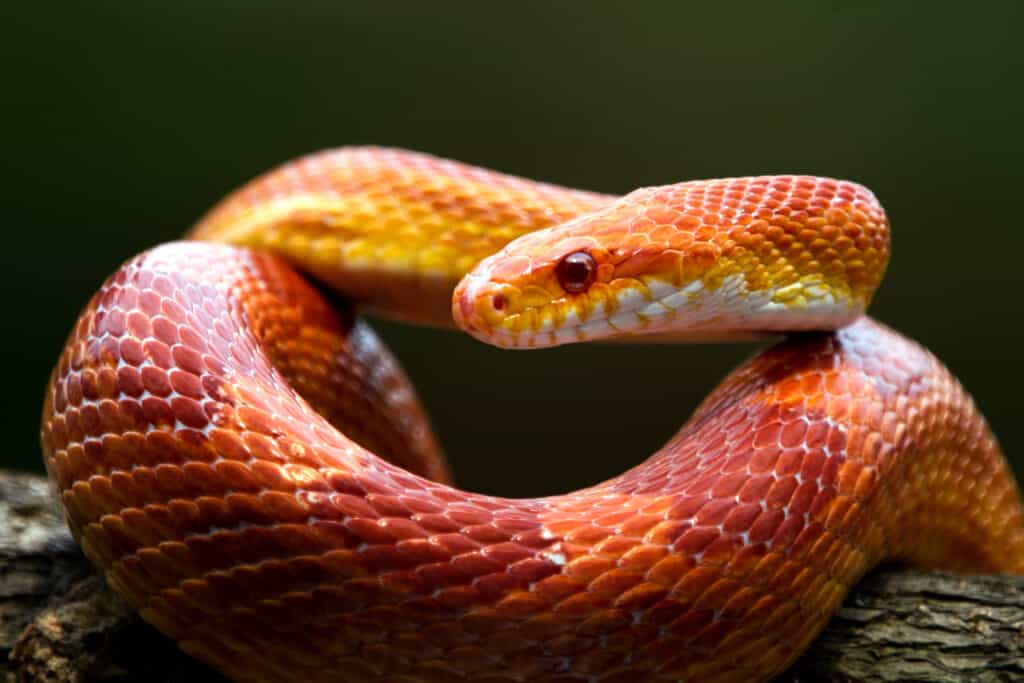Snakes are unique creatures and differ from humans in many ways. For starters, not only do they smell their environment using their tongue and Jacobson’s organ, but they are limbless and often produce venom. Their parental patterns are also very different from humans and mammals – for example, only a few snake species mother their young ones for up to 2 weeks. Otherwise, many are alone immediately after hatching.
Another mor interesting difference between humans and snakes lies in their eyesight. Humans can see up to three primary colors, while snakes can see only two. Consequently, they are thought to be dichromatic in daylight.
On the flip side, there might be similarities between snakes and humans. It’s often thought that snakes can have multiple eye colors, such as yellow, blue, gray, and green. This article takes a look at this claim while studying snake eyes. Can snakes have green eyes? Let’s find out.
Snake Eyes and Their Eyesight
Most snakes have poor eyesight, and there are multiple theorized reasons for this. However, the most probable is that snakes never really needed eyesight. Consequently, they developed other more acute senses.
Remember that snakes are thought to have first appeared about 128 million years ago in warm and forested ecosystems as nocturnal hunters. Snakes were likely nocturnal hunters who relied on their other attributes to hunt prey.
How Well Can Snakes See In The Day?

Unlike humans who can see three colors, snakes can see two.
©iStock.com/Ben185
Since snakes and humans have a communication barrier, scientists took their next best bet in measuring their eyesight; studying the anatomy of their eyes. They discovered that snakes can see two primary colors; blue and green, unlike humans, who can see three.
Most snakes are adapted to nighttime hunting, meaning they can see well in low lighting. This makes them extremely sensitive to ultraviolet light emitted by the sun.
However, some snakes do not fall under this category. The golden tree snake, the vine snake, and some other snake species have lenses that block UV light, allowing them to comfortably hunt during the day without any discomfort due to sensitivity to the light.
How Well Can Snakes See In The Night?
You might probably be wondering: “well, can snakes see in the dark, then?” Sadly, even in the dark, snakes do not have good vision. They may see shapes and outlines but cannot see clearly or as humans do.
Snakes and Infrared Vision

Some snakes have infrared vision.
©ananth-tp/Shutterstock.com
If you’re wondering how snakes became one of the deadliest predators on the planet despite being unable to see, we’ll clear that up. Snakes have a couple of features that make up for their bad eyesight. One of these features is a couple of infrared pits on either side of their face between each eye and nostril (think vertically). These organs allow them to sense or detect infrared radiation.
Although humans cannot see infrared radiation, we can feel it as heat, and as you probably know, living beings give off heat. Humans give off body heat to the tune of 100-120 Watts of energy. One fun fact is that lions give off about 4.5 Watts/pound and weigh 364 pounds on average, giving at least 1,638 watts.
Snakes, however, can detect these radiation waves and create an image from the pattern the heat makes. We imagine that if there were ever a school for snakes, they would be tested on how fast they could recognize objects placed in front of them.
However, not all snakes have infrared vision, as it is reserved for pit vipers, pythons, and boas. Other snakes rely on another special ability to “taste the air,” which we’ll discuss in another section below.
Snakes’ Eyes: Shape and Color

Nocturnal snakes usually have slits for pupils while diurnal snakes usually have round ones.
©Kurit afshen/Shutterstock.com
Snakes have really expressive eyes; they can tell you a lot about them. Nocturnal snakes usually have slits (called elliptical pupils) for pupils, while diurnal snakes usually have round ones. Generally, snakes are known to have yellow eyes, but in reality, their eye color is largely determined by species, amongst other things.
Do Snakes Have Blue Eyes?
Some snakes, such as the blue-eyed leucistic ball python and the emerald tree boa, naturally have blue eyes, but in most other species, blue-gray eyes are an indication that the snake is about to shed its skin. When snakes prepare to shed, their skins become loose, and fluid builds up between the old and new skins. Just before they shed, it is common for their eyes to become blue-gray or milky blue in color.
Do Snakes Have Green Eyes?
Many venomous snakes have black elliptical pupils surrounded by a yellow-green eyeball. However, snakes do not have entirely green or yellow eyes.
Do Snakes Have Black Eyes?
Until recently, snakes weren’t known to have entirely pitch-black eyes. However, in 2015, scientists discovered a new species; Synophis zaheri, with entirely black eyes.
Do Snakes Have Gray Eyes?
The eastern rat snake is one species known to have gray eyes. They are large but nonvenomous snakes commonly kept as pets.
How Snakes See With Their Tongues
Snakes are known for flicking their forked tongues in the air, but many do not know that this action is very important for snakes. They use it to make out their current locations, surroundings, and even to locate their way home.
When snakes flick their tongues, they spread them apart- the distance between them can be twice as wide as their heads. This allows them to collect moisture-laden smell particles. These particles are rapidly submitted to the snake’s Jacobson organ, which is located at the base of the snake’s nasal cavity. The Jacobson organ helps interpret and transmit the particles to the brain.
It is present in reptiles, amphibians, and mammals- even humans. However, only snakes and lizards are known to have developed this ability, while animals like turtles have lost theirs.
The photo featured at the top of this post is © Vladislav T. Jirousek/Shutterstock.com
Discover the "Monster" Snake 5X Bigger than an Anaconda
Every day A-Z Animals sends out some of the most incredible facts in the world from our free newsletter. Want to discover the 10 most beautiful snakes in the world, a "snake island" where you're never more than 3 feet from danger, or a "monster" snake 5X larger than an anaconda? Then sign up right now and you'll start receiving our daily newsletter absolutely free.
Thank you for reading! Have some feedback for us? Contact the AZ Animals editorial team.






